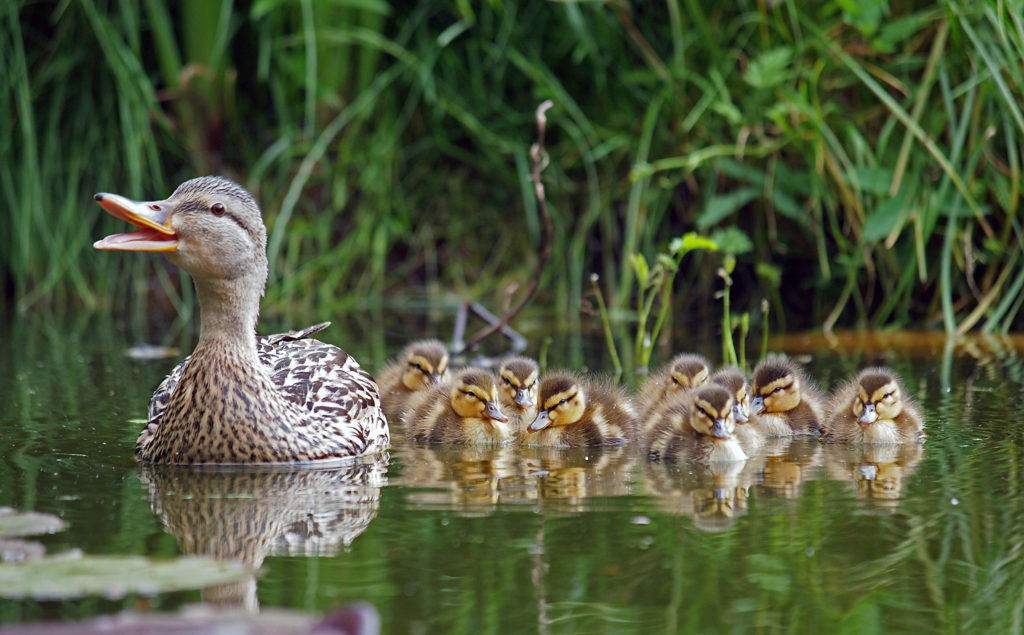
Waterfowl (Ducks, Geese, Grebes, Loons) will pick the strangest places to build their nests, at least from our perspective. We find them up against our house, under shrubbery or in a flower bed. We even find them in the middle of a downtown city location! Regardless of where they are, the rule is: “DO NOT BOTHER THEM!”
There may not be any water for miles, but there’s no need to worry – Mom will escort her young for miles to get them there. Yes, the journey can be treacherous, but in most cases, Mom and the ducklings make it just fine, even if they have to cross Main St. Think about it: wouldn’t you slow or stop if you saw Mom followed by her entourage crossing the street? Most drivers do! For more information read our blog post about how interfering with nature can turn out to be a bad thing.
NOTE: Waterfowl are protected by the Federal Fish and Game and Division of Wildlife laws.
It is illegal for you to take or even touch the eggs.
Simply put, LEAVE THOSE EGGS ALONE!
WHEN TO HELP
Places like nursing homes, hospitals and schools have courtyards that are not open to the outside and can only be accessed from the building. Ducks will often decide to make their nests in these courtyards. In cases like this, a little human help is in order. I do get at least one call about this every year.
Once the ducklings have been hatched and Mom is ready to move them to water, your job is to help gently guide them out of the courtyard, through the building and out the front door.
Setting this up is fairly simple. Close all the doors and access except the front door and the exit from the courtyard. Make sure the path is distinct; you might have to put up chairs with sheets or blankets draped over them, boxes set side-by-side or some other barricades so the ducks only have one way to go, and then walk behind Mom and guide her to the door (DON’T TRY TO CHASE OR CATCH THEM). She will lead the parade from here and take her babies out the door with you following behind.
Waterfowl will lay all of their eggs before incubation begins. This is why all the young hatch the same day. When they do hatch, Mom will sometimes not be seen. This should not be cause for you to intervene. She knows what she is doing.
Interesting fact: Ducklings are NOT water-repellant when they first hatch. It doesn’t take long, but the oils need to get into the feathers.
Grebes and Loons
Nighttime and rain make for tough conditions if you are a Grebe or a Loon. Although they don’t have an issue with flying at night, when you add the rain, they sometimes find themselves in some trouble.
Because these birds land and take off from water, when they see the shiny reflective surface of a parking lot, driveway or road, they think it is a body of water. Landing in these spots can cause a problem, not so much with injuries (although it does happen), but because they become grounded when they can’t take flight from a solid surface.
Their way of taking flight is to use their lobed (not webbed like duck or geese) feet to get a running start on the water’s surface and wing it from there. Not possible from the ground. The lobes, something like the propeller seeds from a maple tree, along with the positioning of their legs, set way back and high on their body don’t allow for them to walk very well on land, so they can’t get a running start. In these cases, a little intervention helps.
With great caution, you may need to help these birds to a body of water. Use caution; they will defend themselves with their sharp beaks, aiming for the eyes if they are handy. Remember, they don’t understand that you are trying to help. To them, you are a predator! I once had a cormorant (similar bird), and in the process of removing him from a pet taxi, he proceeded to pierce my arm to the bone with his beak. Yea, Ouch! The best method to capture them is by throwing a towel, blanket or jacket over them. Better yet, CALL A LICENSED REHABILITATOR before doing anything.
The Loon
The Loon are breathtakingly beautiful. If you see them up close, they look like an angel painted them. They are a diving bird that regulate how high or low they sit in the water by pushing air from their feathers. They can dive down right in front of you, disappear and pop up 200 feet away. They do not like areas with a lot of noise. If you ever see one in the wild, sit back and enjoy their beauty.
REMEMBER:
It is against the law to take their eggs, so leave them alone! If you discover a nest, please just stay away and enjoy watching from a distance.
*** IMPORTANT: Please, please, please DO NOT FEED BREAD TO WATERFOWL. It is detrimental to them. ***
WILDLIFE PROGRAMS AND DISPLAYS
If you would like to see many of these animals up close, please consider booking one of our Wildlife Programs or Displays that are reasonably priced and perfect for Organizations | Schools | Churches | Campgrounds | Nursing Homes | Fundraisers | Displays at Events. All money generated from the programs & displays goes right back into the care of the wildlife.
For more information about our programs, visit our programs page.
Copyright 2017 Fran Kitchen
Operation Orphan Wildlife Rehabilitation, Inc. is a 501(c)3 Non-Profit Organization and does not receive federal funding. We are supported entirely through private donations, memberships, and proceeds from our education programs. Click here to donate.
